Baëtis scambus Eaton - Small Dark Olive
Phylum: Arthropoda - Class: Insecta - Order: Ephemeroptera - Family: Baetidae
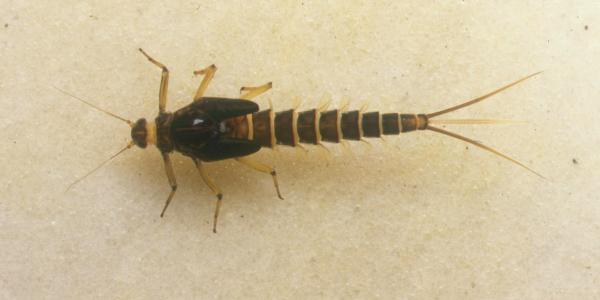
Note: strictly the genus name is Baëtis, but as people searching for information on the internet do not generally include accents (diacritical marks) such as the umlaut accent above the character ë, we have used the easier-to-type Baetis in the main text of this page.
Baetis scambus, the Small Dark Olive, is an insect of flowing water. It is found in steep stony streams as well as in weed-rich chalkstreams. The adults can be seen from spring through summer and into autumn, but the peak of the hatch occurs in July and August.
Nymph
In common with other Baetis flies, the tiny torpedo-shaped nymphs of the Small Dark Olive are slim, agile darters. (Shop-bought Pheasant Tail Nymphs are often much too big and bulky to be effective imitations.) In moderate flows they are able to swim from one weedbed to another in a series of short jerky dashes. As with all members of the order Ephemeroptera found in Britain and Ireland, this insect has three tails in its nymphal stage, and again like other Baetis flies it retains only two when in its winged form.
Immature Baetis scambus nymphs have pale translucent abdomens with darker brown thoraces and wing cases. Its tails have dark central bands. The body develops dark mottling as the insect approaches the time when it will transpose into a dun; nevertheless, it is difficult to distinguish between nymphs of the Small Dark Olive and the Pale Watery (although the latter is on average slightly larger). Fortunately there is no need from a flyfishing point of view, as a slim Pheasant Tail Nymph is an ideal imitation of nymphs of either of these insects.
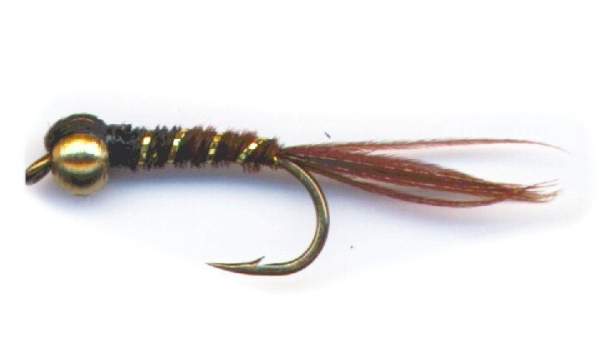
Fishing tip: This really is a very small nymph, and if have a size 18 Pheasant-tail Nymph with a tungsten bead head for fishing deep and a size 18 Gold-ribbed Hare's Ear to represent emergers then you will be very well equipped. Shops in Britain don't usually stock nymphs as small as this (they do in the USA, where flies cost about twice what we are used to paying in Britain and Ireland) so this is another instance where flydressing skills can make a big difference to your flyfishing results.
If you want to achieve a credible imitation of the tiny nymphs the Small Dark Olive and you can't tie your own flies, there is still one more option: order your nymphs from a professional flydresser. They may cost two or three times as much as shop-bought nymphs, but they will be tied on top-quality hooks and they should work well in less turbulent stretches of river where the fish have plenty of time to spot major departures from the form they are used to.
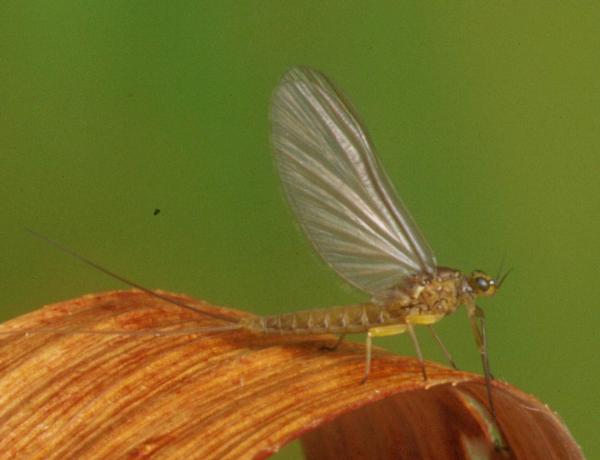
Dun or Subimago
This is a female dun or subimago of Baetis scambus, the Small Dark Olive, which is a tiny fly. Apart from Caenis species it is the smallest of the up-winged flies that occur in Britain and Ireland. Noticeably more swarthy that the Pale Watery, it retains only two tails as it leaves its final nymphal shuck.
Females duns are difficult to distinguish from Pale Watery duns, but it is a lot easier with the males because they have ruddy-orange turbinate (turban-shaped) eyes, whereas males of the Pale Watery have much lighter orange-yellow eyes. I should add that these are not features that would register in the mind of a trout, and so it'd not necessary for a flyfisher to remember this either: it's just interesting!
For chalkstream flyfishers this is one of the most important of the summer flies. When the nymph is ready to 'hatch' into a dun it swims up to the surface; the dun then emerges in open water and takes a few moments for its wings to unfold to the point where it is able to fly.
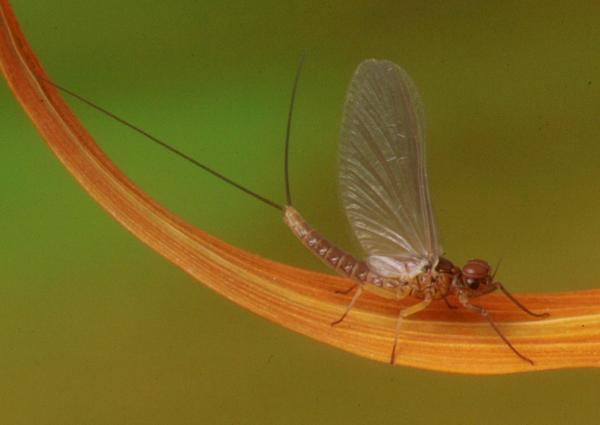
Shown here is the male dun of the Small Dark Olive, Baetis scambus.
During the time that the dun is escaping from its nymphal shuck and pumping fluid into its wing veins to 'inflate' its wings, it is potentially a meal for a trout. The emerger and dun stages are what we can mimic with matching artificial flies.
The last three abdominal segments of the male Small Dark Olive dun have an orange tinge, while the forward segments are more obviously olive; however, as with all up-winged flies the most obvious distinction between males and females is eye size. Males have much larger eyes than females, and with Baetis species the turbinate form of the eyes of males only serves to exaggerate this difference.
On lowland spate rivers and streams, the Small Dark Olive hatches are invariably concentrated in riffle and glide sections, while the deeper pool habitats are too silt-laden and slow flowing for the nymphs of this species.
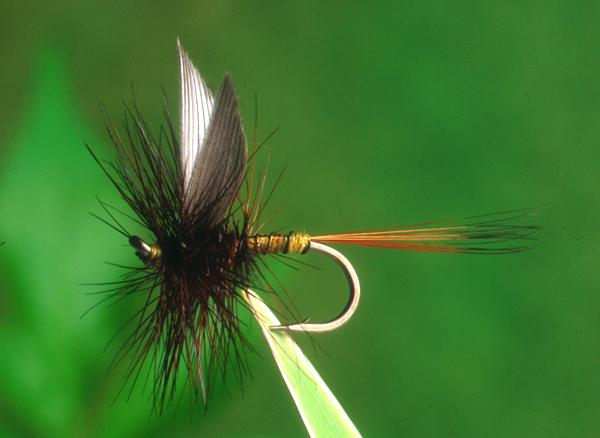
Greenwell's Glory - a very useful general representation of olive duns.
During the main summer hatching period of the Small Dark Olive, duns can come off the water from just before midday until dusk descends, and as a result rises to Small Dark Olive duns can be seen throughout the day, particularly in dull and muggy weather.
Flyfishing tip
Very bright sunlight during high summer (not a weather feature we can rely on in Britain and Ireland!) can make daytime fishing very tough, as the hatches tend to be concentrated into an hour or so in early to mid morning and a similar burst of activity around dusk. If you can find a tree-lined stretch where you are fishing from the southern side of the river and casting under trees of a northern bank, then it is much more likely that Small Dark Olives will be hatching in the shade of the trees and that trout will have learned about it and moved in to feed there.
In the turbulent water of a spate-river riffle trout have little time to decide whether a fly is genuine or not. There a general olive representation such as Greenwell's Glory should work fine, and a size 18 is a good match for the Small Dark Olive dun hatch. On gently-flowing chalkstreams and on clear, slow-flowing lowland limestone rivers such as Ireland's River Fergus, a closer imitation can often make all the difference between success and failure.
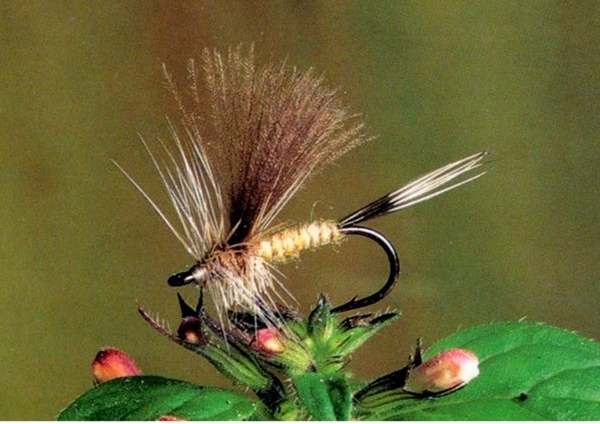
Duck's Dun, tied by Charles Jardine
In Matching the Hatch you will find tying details for Charles Jardine's tying od Duck's Dun, an excellent dry fly designed specifically for this purpose and a very good match for the Small Dark Olive, Medium Olive, Pale Watery and Pale Evening duns. It looks very realistic when viewed from under the water - the only real test for a dry fly.
When I fish for wild trout on small pools and lakes during a hatch of Pond Olives, I find that the version of Duck's Dun devised by Charles Jardine is a more effective imitation of the natural insects than any other pattern I have yet come across.
Overwintered stocked trout that have become used to lures and fancy flies can also be tempted by an artificial fly that matches the hatch that they have locked on to, and there's an extra sense of satisfaction in knowing that your quarry is a discerning one.
Spinner or Imago
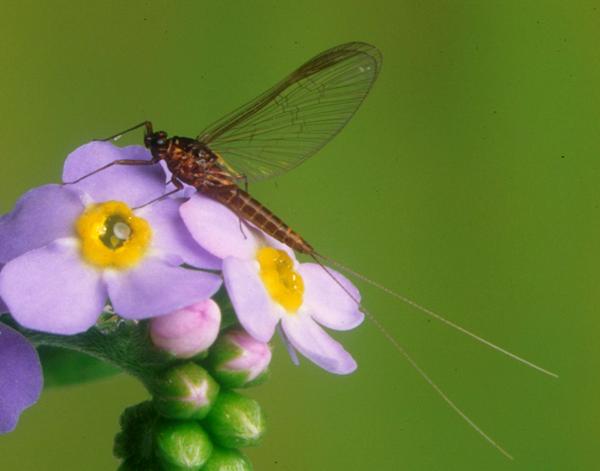
A female Large Dark Olive spinner
The female Small Dark Olive spinner is reddish brown in the body - hence it is sometimes referred to as the Small Red Spinner. The male spinner is distinguished by a translucent cream body with the last three segments flushed orange-brown, very much like a male Pale Watery spinner but somewhat smaller and with ruddy-brown rather than yellow turbinate eyes,
The female lays her eggs on emergent rocks, marginal reeds or branches extending beneath the surface, and so the main opportunity that trout get to feed on spinners is when, egg-laying completed, they drift back up to the surface. Many are carried away on the current, and as they drift downstream struggling in the surface film they are very visible to trout.
Spent spinners, their wings spread out on the surface of the water, are best imitated by a fly tied with spent wings and without hackles. Brian Clarke's Polythene-winged Spinner is ideal - see Matching the Hatch for tying details.
Similar Species
Baetis fuscatus, commonly known as the Pale Watery, is slightly smaller and paler but otherwise very similar to the Small dark Olive; its hatching period is shorter than that of Baetis scambus and it is not a widespread in distribution and on most rivers is less abundant. For flyfishing purposes these two up-winged flies can be treated as one and the imitation recommended above will work equally well as imitations of either species.
Techniques for making an artificial nymph imitate the behaviour of a Baetis nymph and tactics for dry-fly fishing during a hatch of Large Dark Olives are covered in more detail in Matching the Hatch.
Excited at the prospect of flyfishing? So are we, and we're pretty sure you would find the Winding River Mystery trilogy of action-packed thrillers gripping reading too. Dead Drift, Dead Cert, and Dead End are Pat O'Reilly's latest river-and-flyfishing based novels, and now they are available in ebook format. Full details on our website here...
Buy each book for just £4.96 on Amazon...
Please Help Us: If you have found this information interesting and useful, please consider helping to keep First Nature online by making a small donation towards the web hosting and internet costs.
Any donations over and above the essential running costs will help support the conservation work of Plantlife, the Rivers Trust and charitable botanic gardens - as do author royalties and publisher proceeds from books by Pat and Sue.
